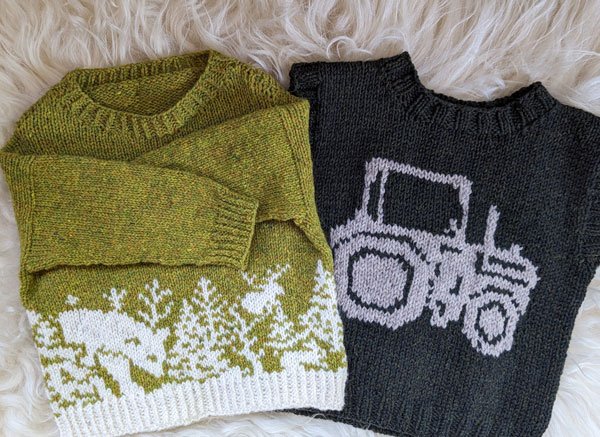Summer Knitting: Sweaters for Little Ones
At My Sister Knits, we’re looking for comfortable summer projects to work on in the heat. Even air conditioning doesn’t always make working on a full-sized wool project pleasant. We have two good options for this challenge………..work with a plant-based fiber such as cotton, linen, and raw silk, or make something little! I have both types of projects going and it’s the little ones that have my attention right now.
I have a grandbaby arriving in November and this dear little babe will need all sorts of wooly garments! If you have a child in your life, small sweaters are perfect summer knits! They don’t take up much room on your lap and they are quick to knit. If you’re like me, you’ll feel so satisfied and a little bit proud of yourself as your pile of warm wooly wonders grows.
Flax is knit with worsted weight, Flax Light with fingering weight
Flax and Flax Light are part of the Tin Can Knits Simple Collection. They are free patterns in their Learn to Knit series. Tin Can Knits is well known for its excellent tutorials and clear directions aimed at the beginning knitter. If you’ve never knit a sweater, you should give these patterns serious consideration!
Our three samples on display are knit with three different yarns. It’s an excellent way to see how different yarns feel when worked up!
Wee sweaters are also good for trying out new skills. We have several on display with colorwork. Keep in mind that the term ‘colorwork’ doesn’t just mean stranded (sometimes known as Fair Isle) colorwork, it refers to anything with more than one color: stripes, marled, mosaic, and intarsia are also colorwork techniques.
Both of these sweaters are designed by Petite Knits. The top one is Melange Sweater Baby and the bottom is the sweater from Seaside Set.
The sweater from the Seaside Set has a side placket and stripes. I love any baby sweater that has an offset closing. Babies’ necks are barely existent and the last thing they need is buttons under their chin! Stripes are so much fun to play with! Go to the projects page on Ravelry and you’ll find all sorts of inspiration!
Melange Sweater Baby is a marled sweater, meaning you hold two colors together as you knit. Marling shows up best with two high-contrast yarns. Wouldn’t it be fun to put a couple of brights together?
On the left is Little Woodland, designed by Anna Johanna. On the right is Tractor Sweater, designed by Knitting for Olive
When I first looked at our Tractor sample, I thought it was Intarsia but it isn’t. I’d much rather do stranded colorwork because I’m more familiar with it. If you make this, you’ll just need to catch your floats every 4 or 5 stitches. Using a ‘sticky’ yarn will help the strands grab onto each other. This pattern has an unusual construction; you start at the bottom front, work up and over the shoulders, and down the back! Then you get to practice your seaming on the sides. Here’s a video for the mattress stitch. Or come into the shop and we’ll show you how!
Little Woodland also has an unusual construction for the neck and shoulders but the directions are thorough. There is short row shaping and if you’d rather use our favorite German short rows than the Wrap and Turn method, here’s a video to explain how. The colorwork charts look a bit daunting at first but then they become clear. Anna was quite clever with the way she wrote them!
We have more small sweaters in the shop, both on display and on our sample rack upstairs. We invite you to feel them to see the difference in the yarns used. This will help you decide not only which weight to use but which type of yarn you prefer!
Happy knitting,




